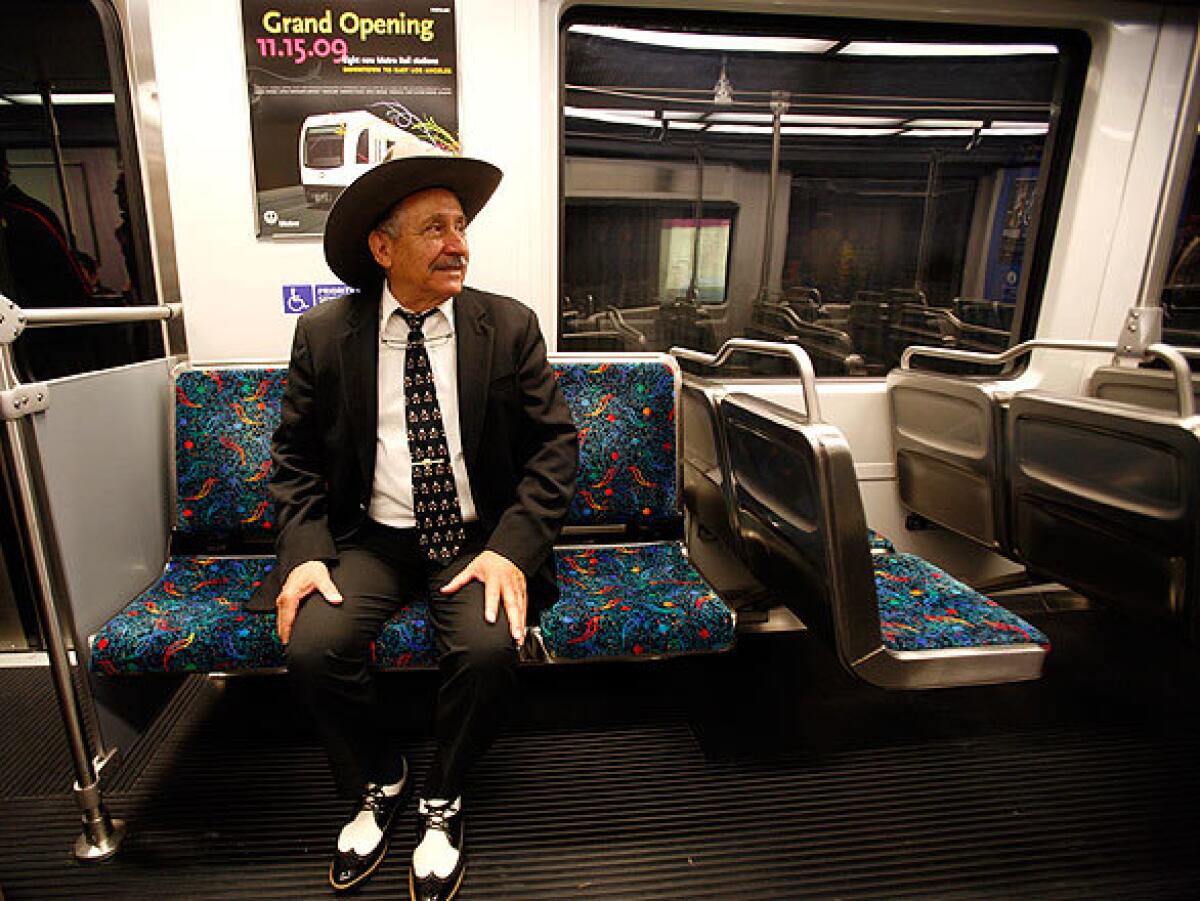Recalling the Yellow Cars while riding the Gold Line extension

- Share via
When Armando Ybarra was a teenager in the early 1950s, he used to take an old hulking streetcar to school and work on the Eastside.
The fare was about 10 cents, and when the trolleys were too crowded, he would simply grab ahold of something and ride on the outside of the car.
“People were very friendly, very sociable, and you’d feel comfortable,” Ybarra, now 70, said, remembering how the streetcar operator would ring a bell and call out the name of each stop.
The Yellow Cars disappeared in the early 1960s. But on Friday, Ybarra was invited for a preview of rail’s future on the Eastside.
The old days flashed back as Ybarra took a ride on the new Gold Line extension, which runs from Union Station to East L.A. and will open to the public Nov. 15.
There’s no hanging out from the trolley doors, and the bulky cars have given way to a sleek machine that will cost riders $1.25 a trip.
He sat on a multicolored seat and stared out the window of the new light-rail line before remembering why he liked riding the rails so much as a young man: the diversity of people on board, the ability to have relaxed conversations with other passengers and the freedom from the hassles of driving.
“You felt like a community to ride the trains,” said Ybarra, who went to high school on the Eastside and now lives in Whittier.
He said he was impressed by the light rail: “state-of-the-art, quiet, smooth, [with] nice comfortable seats.”
The train left Union Station in downtown Los Angeles and sped above the 101 Freeway to Alameda Street before turning east on 1st Street. The extension is about six miles long, roughly 1.7 miles of which are twin tunnels that run underneath Boyle Heights.
He was part of a “sneak peek” tour, and his fellow passengers were other residents, as well as dignitaries including Mayor Antonio Villaraigosa and county Supervisor Gloria Molina.
Los Angeles Councilman Jose Huizar, who was on the tour and grew up in the area after the trolley disappeared, said “you hardly got to explore the rest of Los Angeles” back then.
He said that the Los Angeles River has long been the dividing line between the east and west and that the new light-rail line, which crosses the river on the 1st Street bridge could help “bring L.A. closer together.”
Ybarra wore a cowboy hat and black and white dress shoes and sat away from the politicians.
“Oh, wow!” he said as the train went into the tunnel. Ybarra said the journey reminded him of the days when Boyle Heights was a heavily Jewish district where it was easy to find corned beef and pastrami. Today it is overwhelmingly Latino.
The tour stopped at the underground Soto station, where a blown-up map of Boyle Heights covered one wall and nearby a sculpture of a bird’s nest was suspended from the ceiling and held a pulsating acrylic egg.
“That’s very, uh, creative,” said Ybarra, who works for the L.A. Department of Water and Power.
The trip continued and Ybarra pointed out some of the local businesses he now frequents, like Neshek’s Auto Repair on East 3rd Street. The tour stopped at the end of the tracks, Atlantic Boulevard, and then turned back.
“I liked the design, contemporary, it’s fresh,” Ybarra said later. “I felt real good about it; I was reminiscing. It was good memories. I could close my eyes and I could visualize that I was back in the ‘50s, riding the P, R, or J lines, and it was a good feeling.”
More to Read
Sign up for Essential California
The most important California stories and recommendations in your inbox every morning.
You may occasionally receive promotional content from the Los Angeles Times.










